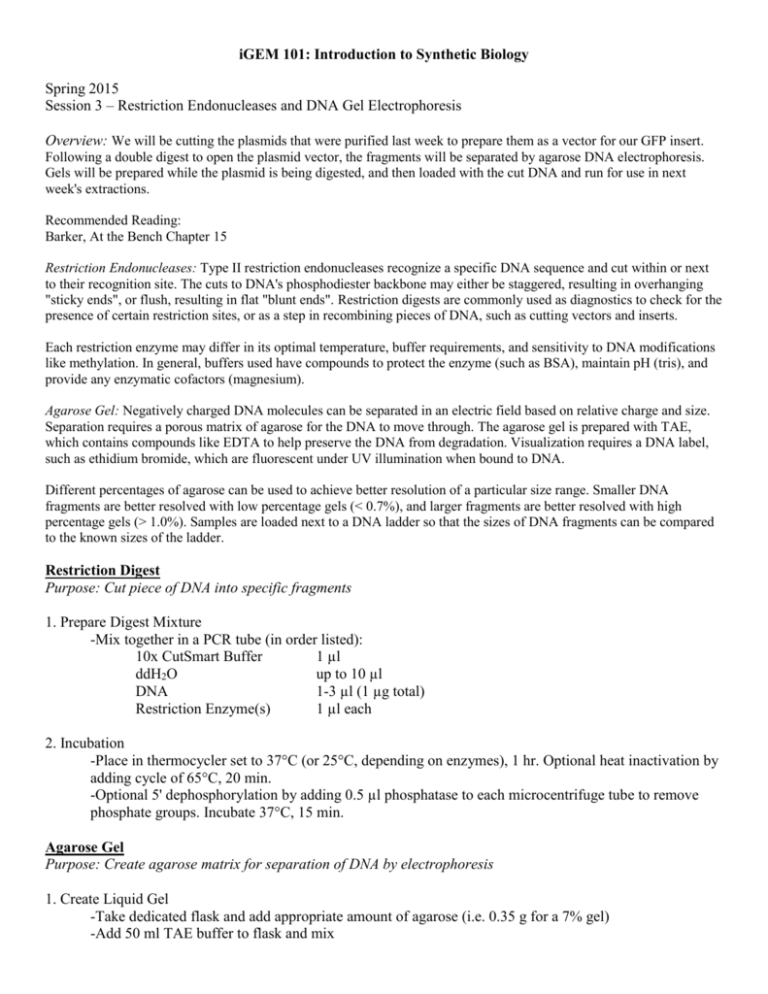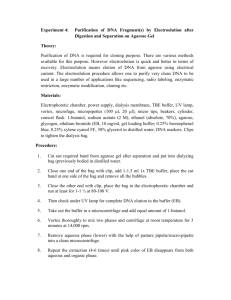iGEM 101 – Session 3 Handout
advertisement

iGEM 101: Introduction to Synthetic Biology Spring 2015 Session 3 – Restriction Endonucleases and DNA Gel Electrophoresis Overview: We will be cutting the plasmids that were purified last week to prepare them as a vector for our GFP insert. Following a double digest to open the plasmid vector, the fragments will be separated by agarose DNA electrophoresis. Gels will be prepared while the plasmid is being digested, and then loaded with the cut DNA and run for use in next week's extractions. Recommended Reading: Barker, At the Bench Chapter 15 Restriction Endonucleases: Type II restriction endonucleases recognize a specific DNA sequence and cut within or next to their recognition site. The cuts to DNA's phosphodiester backbone may either be staggered, resulting in overhanging "sticky ends", or flush, resulting in flat "blunt ends". Restriction digests are commonly used as diagnostics to check for the presence of certain restriction sites, or as a step in recombining pieces of DNA, such as cutting vectors and inserts. Each restriction enzyme may differ in its optimal temperature, buffer requirements, and sensitivity to DNA modifications like methylation. In general, buffers used have compounds to protect the enzyme (such as BSA), maintain pH (tris), and provide any enzymatic cofactors (magnesium). Agarose Gel: Negatively charged DNA molecules can be separated in an electric field based on relative charge and size. Separation requires a porous matrix of agarose for the DNA to move through. The agarose gel is prepared with TAE, which contains compounds like EDTA to help preserve the DNA from degradation. Visualization requires a DNA label, such as ethidium bromide, which are fluorescent under UV illumination when bound to DNA. Different percentages of agarose can be used to achieve better resolution of a particular size range. Smaller DNA fragments are better resolved with low percentage gels (< 0.7%), and larger fragments are better resolved with high percentage gels (> 1.0%). Samples are loaded next to a DNA ladder so that the sizes of DNA fragments can be compared to the known sizes of the ladder. Restriction Digest Purpose: Cut piece of DNA into specific fragments 1. Prepare Digest Mixture -Mix together in a PCR tube (in order listed): 10x CutSmart Buffer 1 µl ddH2O up to 10 µl DNA 1-3 µl (1 µg total) Restriction Enzyme(s) 1 µl each 2. Incubation -Place in thermocycler set to 37°C (or 25°C, depending on enzymes), 1 hr. Optional heat inactivation by adding cycle of 65°C, 20 min. -Optional 5' dephosphorylation by adding 0.5 µl phosphatase to each microcentrifuge tube to remove phosphate groups. Incubate 37°C, 15 min. Agarose Gel Purpose: Create agarose matrix for separation of DNA by electrophoresis 1. Create Liquid Gel -Take dedicated flask and add appropriate amount of agarose (i.e. 0.35 g for a 7% gel) -Add 50 ml TAE buffer to flask and mix -Prepare plastic shell, tray, and well maker for gel pouring using TAE buffer for lubrication if necessary -Microwave for approximately 90 sec or more until solution clear *Plug loosely w/ paper towel cap to prevent evaporation -Carefully add 2 µl of ethidium bromide and mix until the liquid is clear *Ethidium Bromide is highly toxic as well as mutagenic and teratogenic: DO NOT spill and discard pipette tips into dedicated container -Pour agarose mixture slowly and evenly. Remove any bubbles/imperfections with pipette tip -Let set for 20 min minimum -Fill apparatus with TAE buffer until the gel is submerged 2. Transferring DNA -Remove well comb and rotate the gel into the correct orientation -Add 5 µl of the appropriate ladder to the first well -Add 6x DNA Loading buffer to DNA samples at 1:5 dilution -Minicentrifuge PCR tubes to collect genetic material -Transfer material from tubes to wells -Run gel @ 45 min; 120 V *Always run to RED






